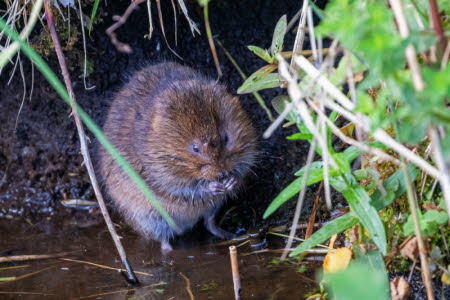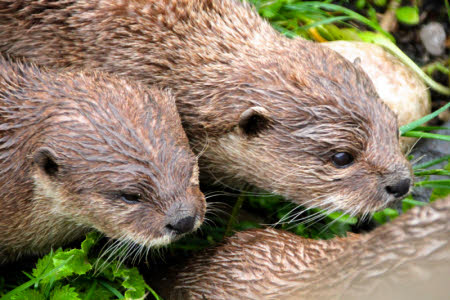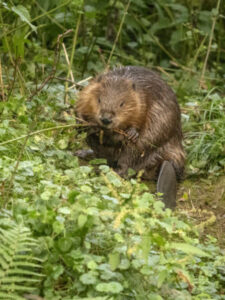To be written
There are three Focus SpeciesA group of similar organisms that can breed and exchange gen... More in this group: water vole, otter and beaver.
Water voles have been re-introduced to Devon but are still under threat from mink
Beavers are now found across large parts of Devon and creating wetlands which help to reduce flooding.
Otters are found across the whole county.
All freshwater mammals need stable riverbanks and a vegetated riparian corridor for food, shelter and breeding sites. However, activities such as heavy grazing by livestock, infrastructure schemes, insensitive river engineering and maintenance works have all caused loss, fragmentation and deterioration of this habitatThe natural environment in which an animal, plant or other o... More.
American mink were first found breeding in the wild on the River Teign in Devon in 1957 and remain widespread. Water voles are particularly vulnerable to predation by American mink, which catch them in the water and in their burrows. A female mink with kits to feed can easily wipe out an entire water vole colony.
Ash dieback along rivers may affect the number of breeding sites available to otters. Ash trees are often large, with hollows under their roots. When the tree dies and falls over, the roots are pulled up and the spaces underneath are lost.
Otters feed on fish, crustaceans and other invertebrates which may contain heavy metals and toxic chemicals (such as polychlorinated biphenyls) that pollute the water from discharges, sewage and road and agricultural run-off. Some of this pollution can persist in the environment for many years. The otter population in Britain crashed in the 20th century and one of the main reasons was the introduction of organochlorine pesticides. Otter populations have now recovered but are still vulnerable to pollution.
Otters feed on fish, crustaceans and other invertebrates which may contain heavy metals and toxic chemicals (such as polychlorinated biphenyls) that pollute the water from discharges, sewage and road and agricultural run-off. Some of this pollution can persist in the environment for many years. The otter population in Britain crashed in the 20th century and one of the main reasons was the introduction of organochlorine pesticides. Otter populations have now recovered but are still vulnerable to pollution.
Species such as eels and bullheads are an important food source for otters and both are affected by pollution. Eels are now endangered (see Fish for more information). No Devon rivers are classed as being in Good Chemical Status or High Environmental Status and less than a quarter are in Good Environmental Status. See Watercourse corridors for more information.
Road traffic is now one of the biggest dangers for otters, and may become a danger for beavers as their population expands across Devon. Otters and beavers are at most risk when moving between river catchments or during high flows when they can’t pass through bridges and culverts and are forced up onto roads.
The Environment Agency estimates that, on average, one otter is killed on Devon and Cornwall’s roads every month.Crossings have been put in place at some of the known black spots on the M5, the A361, A30 and A38 but these need to be monitored and more are needed.
Fyke nets (fish traps used in shallow coastal waters) and crayfish traps can drown otters if they aren’t set with an otter guard.
Reported incidents of otters feeding at fish farms and fishing lakes have increased. Advice is available from the Environment Agency and the Angling Trust to help protect fish stocks. Talk to EAEnvironment Agency More – more info needed on whether this is a problem and link to their advice?
There is currently no strategic approach to the conservation of water voles across Devon. For example, organisations such as the Environment Agency and local authorities are unable to help with conservation efforts because they’re not being told where and when water voles are released. There is no countywide group for beavers. There is a need for a more strategic approach to conservation efforts for all three species.
See Watercourses page for an overview. There are lots of projects underway across Devon which will enhance habitat for freshwater mammals, including work by Devon Wildlife Trust and others on beavers, community projects to re-introduce beavers, Landscape Recovery Projects and Natural Flood Management projects such as the Dartmoor Headwaters Project. See Inspiration and Find out more below.
Generate funding???
Beavers are ecosystem engineers. Their dams slow the flow of water and create wetland habitatsThe natural environment in which an animal, plant or other o... More. Benefits include a reduced risk of flooding downstream, better water quality, enhanced wildlife and more resilient water supplies. Exeter University is developing a model to predict the benefits of beavers move into a catchment. There are opportunities to link these benefits to funding for beaver conservation projects. – is this happening?
Community groups are leading more and more projects, for example to restore rivers, release and monitor voles and control mink.
Communities are also involved in lobbying and increasing the pressure on water companies to improve water quality and the health of our rivers.
See Find out more below for where to find detailed species records.

Water voles are our largest voles. They mainly live along well-vegetated banks of slow flowing rivers, ditches and lakes (and sometimes reed beds and marshes) where they have cover from predators and can feed on a wide range of vegetation. They have a territory of around 130m along the banks and are thought to travel up to 3km to establish new territories.
Water voles dig extensive burrow systems in banks with entrances above and below the water. They can also make aerial nests in wetlands when there are no banks to burrow into (has this ever happened in Devon?). They usually have three or four litters a year.
Unlike many other British mammals, water voles tend to be active during the day. Signs that they’re present include closely grazed ‘lawns’, sometimes with piles of chopped food near the burrow entrance, a characteristic ‘plop’ when they enter the water and deposits of distinctive shiny black faeces.
During the 1980s and 1990s, the once widespread water vole population declined by 90%. This was partly due to loss of habitat but was mainly because of predation by American mink. Water voles are classed as endangered, are a UK Priority species and are legally protected. In Devon they were declared extinct in 2002 and various reintroductions are taking place across the county. What’s the mink situation?

Otters are one of Britain’s largest carnivores. They’re solitary mammals and their territories can cover up to 20kms of riverbank. They mark their territory with faeces (spraint), which can be found in prominent places such as on rocks.
Otters live in both coastal and freshwaters. They create dens (known as holts) in riverbanks, generally in tree root systems, holes or under rocks. They mainly eat salmonid fish, eels and crayfish although sometimes eat birds such as coots and ducks and, in the spring, frogs and toads. They need clean rivers with an abundant, varied supply of food, plenty of bank-side vegetation to provide cover for lying up during the day and secluded sites for holts. Wetlands provide an important habitat for raising their young as well as frogs and toads for food. Otters breed all year.
The otter population in Britain and western Europe declined dramatically between the mid-1950s and the mid-1970s. This was largely due to the introduction of organochlorine pesticides but also due to habitat loss and hunting. In the 1977-81 national survey, signs of otter were only found in 6% of sites in England. Since then the population has slowly recovered due to the ban of organo-chlorine pesticides, legal protection in 1978 and better water quality.
Otters are found on all Devon’s rivers and the population is thought to be healthy. However, as they remain vulnerable to impacts such as pollution, and as Devon is a national stronghold, the Environment Agency has said they should be a Focus Species in the LNRS. They are a UK Priority Species, are legally protected and also a qualifying feature of the Dartmoor SACSpecial Area of Conservation More.

Beavers are Britain’s largest rodent. They live in freshwater habitats such as rivers, streams and ponds, preferring areas that are surrounded by woodland. Their river territories are around 3kms.
Beavers dig burrows (known as lodges), which have their entrance below water level. They live in family groups of an adult pair and their offspring. Between one and six young, called kits, are born between May and June. They leave when they’re around two years old to set up a new territory.
Like water voles, beavers are herbivores. In winter they eat tree bark and in Devon favour willow, poplar, hazel and birch. In summer they eat a wide range of non-woody vegetation. In autumn they sometimes create a food reserve of branches and twigs, which they store underwater close to the entrance of their lodge.
Beavers are great swimmers but slow on land so they prefer to be near water that’s at least 70cms deep. They’re known as ecosystem engineers because they build dams of mud, wood, plant material and stones across shallow watercourses and ditches to create deep ponds. They also build bunds across fields to create new ponds and canals to help them move vegetation back to their lodge.
Beavers were once widespread across Britain but by the end of the 16th century had been hunted to extinction. However, since 2000, there have been official and unofficial beaver releases across the country. In 2013, beavers were seen on the River Otter in Devon (see Inspiration below) and there are now wild beavers in the Otter, Tamar, Taw and Exe catchments.
Beavers’ engineering works have many benefits. They create habitats for a wide range of other species, including water voles. New wetlands slow the flow of water and can help to prevent flooding downstream, as well as acting as a buffer to watercourses and improving water quality. While this will benefit fish populations there are concerns that dams may create barriers and prevent fish such as shad (see Fish) from reaching critical spawning grounds. There are also potential conflicts with landowners and highways as beavers can flood land and fell trees across roads.
See the Watercourse corridor page for actions relating to water quality and restoring a wildlife-rich riparian zone.
Actions above are relevant to all three species other than mink control which is only relevant to water voles. See Mapping for more information and the Viewer.
High Opportunity Areas:
Water voles: Water vole zones. However, mink control needs to take place across Devon and ideally the south west peninsula.
Otters: All watercourse corridors.
Beavers: Beaver opportunity areas have been mapped in catchments with beavers. These show good riparian habitat (which needs to be maintained) and poor habitat in need of restoration. Note that this mapping isn’t just relevant to beavers and can be used to target actions for general restoration of riparian habitat.
The catchments which currently support beavers (Otter, Tamar, Taw and Exe) are also shown on the Viewer.
Case studies and Where to visit will be agreed following discussion through public consultation period and then finalised.
There’s lots of great work going on across Devon for freshwater mammals. For example:
To be agreed and added later. Possible case studies
River Otter Beavers – Communities involved in water vole projects. Upland wetland projects.

Always follow the Countryside Code and keep to footpaths and sites that are managed for public access.
Good places to see freshwater mammals are:
Add later – including River Otter, Budleigh (beavers) and Seaton Marshes (water voles)
For information on visiting these and other sites that are open to the public please see the Explore Devon website.
Add more links and tidy up, and finalise following discussion through public consultation.
The NBN Atlas has species records and a search function that pulls up records for a specific area. Health warning: The Atlas shows records submitted and not the actual distribution of species. Therefore absence on the map does not mean absence. Some of the records are also quite old and the species may no longer be present.
Devon Biodiversity Records Centre (DBRC) collects, manages and makes available records of wildlife. Note: they may charge depending on the reason for the request.
iNaturalistUK helps you identify wildlife and share records.
Riparian habitat management
The Forestry Commission has a design guide on woodland design for nature recovery, including water benefits.
The Forestry Commission has a practice guide on Creating and managing riparian woodland.
Natural Scotland and the Scottish Environment Protection Agecny have produced a good practice guide on river crossings.
The Water Vole website has information on water voles.
The People’s Trust for Endangered Species is inviting people to register as water vole surveyors and take part in the national water vole monitoring programme.
The Wildlife Trusts lead the National Water Vole Database and Mapping Project, which brings together and maps data on water voles and American mink.
The Game and Wildlife Conservation Trust has information on how to build and use a mink raft.
Known water vole reintroductions in Devon – need to check and sort out links or delete them
Dawlish Warren and Starcross (2009): still present in the area.
Tale Valley Trust (2004-2006) new link needed https://www.exeter.ac.uk/media/universityofexeter/research/microsites/creww/riverottertrial/appendix2/River_Tale_Mammal_Survey_for_DMG_-_M_Newman_June_2016.pdf
Lower Axe Valley, (including Seaton Wetlands) and the River Tale, River Coly and Offwell Brook (2008-2011): run by the Devon Water Vole Recovery Project, the project also carried out mink control and gave advice to landowners. Water voles are still present on the River Tale and at Seaton Wetlands, though it is not known if they are still present at some of the other sites. https://www.mammal.org.uk/wp-content/uploads/2023/05/Mammal-Communications-Water-vole-and-beaver-coexistence2.pdf new link needed
Seaton Wetlands (2017-present): water voles were released in 2017 and 2018 to bolster the population released in 2008 https://www.mammal.org.uk/2018/10/water-voles-on-the-east-devon-wetlands/
River Gara (2023): project run by the Habitat Group.
Hayes Meadow, Exbourne (2021): https://www.hayesmeadow.com/hayes-meadow-water-vole-sanctuary-release/ new link needed
Avon Valley (2020-2021): run by the South Devon Water Vole Project. Water voles were originally reintroduced to Devon Birds’ South Huish Nature Reserve in 2010. Local volunteers were trained to survey for water voles, and new locations were found in the Avon Valley, some distance from the original release site.
Essebere Farm, Witheridge (2020): project run bythe Dayshul Brake rewilding project, which has also released beavers.
Braunton Marshes: a release is being planned.
Natural England have published the Ecology of the European Otter, by Paul Chanin
In 2011, The Guardian published an article, Otters are back – in every county in England
Data
The Environment Agency published the Fifth Otter Survey of England 2009-2010
Operation Otter is a volunteer-led, quarterly otter survey which takes place across Devon. The survey has been running since 1997, however a lack of funding means it has been difficult train new volunteers and few sites are surveyed now.
Contact DBRC for data from surveys in East Dartmoor NNR, Exeter, Exmoor and the Axe Valley.
The Environment Agency records otter roadkills and sends data from corpses to the Cardiff University Otter Project for post-mortem (see Research below).
Research
Cardiff University’s Otter Project is a long-term environmental surveillance scheme that uses otters found dead to investigate contaminants, disease and population biology across the UK. The data the project gathers on certain bioaccumulating toxic chemicals in otter tissue will be used by the Environment Agency as part of the environmental monitoring programme for toxic pollutants under the Government’s Environmental Improvement Plan. Link?
West Dart River Valley between Two Bridges and Hexworthy is the only area of the Countryside and Rights of Way (CROW) Act Access Land where dogs were completely excluded all year around to protect otters. This exclusion was reviewed in 2018, and dogs are now allowed, but must be kept on a lead.
Legal protection
A European Protected Species mitigation licence is required if any work is carried out within 30m of an otter holt or lying up site.
Devon Wildlife Trust’s website has lots of information about beavers, including a report on the River Otter Beaver Trial.
The East Devon Beaver Management Group oversees responses to wild beaver activity in catchments in the East Devon area.
The Tamar Beaver Management Group oversees reponses to wild beaver activity in catchments in the whole Tamar River catchment.
The Mammal Society website, The Wildlife Trusts website and the Beaver Trust’s website all have information on beavers.
In 2021, the Natural History Museum published an article, Record numbers of beavers are being introduced to the UK.
Beaver Management has information and advice on how we can successfully live alongside beavers.
GOV.UK has information on how to manage beavers in England.
Devon Wildlife Trust has information on how to build a network of nature-rich rivers and wetlands where beavers and other wildlife can flourish.
The University of Exeter has published research into predicting the location and number of beaver dams.
Beaver releases
Beavers have also been released into a fenced enclosures at Upcott Grange, Lifton as part of the Combeshead rewilding project and on the Little Dart, near Witheridge, as part of the Dayshul Brake rewilding project. There is also a new release planned for a site on Dartmoor in 2023.